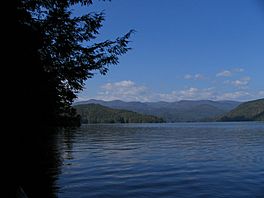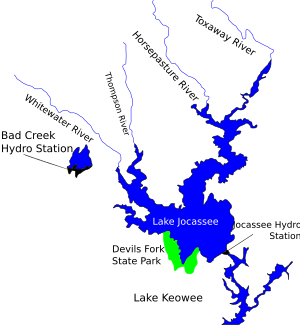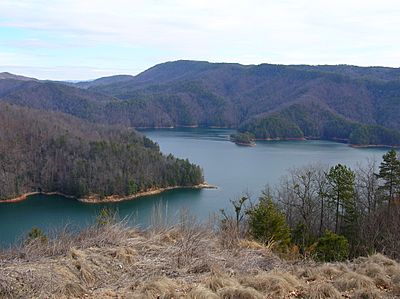Lake Jocassee facts for kids
Quick facts for kids Lake Jocassee |
|
|---|---|
 |
|
| Location | Oconee / Pickens counties, South Carolina, United States |
| Coordinates | 34°57′36″N 82°55′10″W / 34.96000°N 82.91944°W |
| Type | Reservoir |
| Primary inflows | Horsepasture, Toxaway, Whitewater, Thompson Rivers |
| Primary outflows | Keowee River |
| Basin countries | United States |
| Surface area | 7,500 acres (30 km2) |
| Average depth | 158 ft (48 m) |
| Max. depth | 326 ft (99 m) |
| Shore length1 | 75 mi (121 km) |
| Surface elevation | 1,100 ft (340 m) |
| Frozen | Yes |
| Islands | Dozen small islets |
| Settlements | Clemson, Pickens, Salem, and Seneca |
| 1 Shore length is not a well-defined measure. | |
Lake Jocassee is a large, man-made lake in the northwest part of South Carolina. It covers about 7,500 acres (30 km2) and is very deep, reaching up to 326 ft (99 m) in some spots. The lake was created in 1973 by the state and Duke Power.
Lake Jocassee is famous for its super clean and cold water. This is because it's fed by rivers flowing from the Appalachian Mountains. The Jocassee Dam holds back the water, forming the lake. This dam is 385 feet (117 m) tall and 1,750 feet (530 m) long! You can find the lake inside Devils Fork State Park.
Before the lake was filled, most buildings in the area were removed. But recently, divers found the remains of a lodge deep underwater. It's now about 300 feet (91 m) below the surface! Also, a cemetery called Mount Carmel Baptist Church Cemetery was used in the movie Deliverance (1972) before the lake was created. That spot is now covered by 130 feet (40 m) of water.
Many beautiful waterfalls flow right into Lake Jocassee. These include Laurel Fork Falls, Mill Creek Falls, Wright Fork Falls, and Moondance Falls.
Contents
How Lake Jocassee Gets Its Water
Lake Jocassee gets its water from four main rivers. The Whitewater River flows into the lake from the northwest. The Thompson River also joins the lake in the northwest corner.
From the northeast, the Horsepasture River and the Toxaway River feed into Lake Jocassee. All these rivers bring fresh, cool water from the mountains.
The Jocassee Hydro Station is a power plant at the southeast end of Lake Jocassee. It separates Lake Jocassee from Lake Keowee. Lake Keowee was formed over the old Keowee River. Unlike Lake Keowee, which has many homes built around it, Lake Jocassee is mostly undeveloped. This is because Duke Power and the State of South Carolina own most of the land around it.
Nature and Wildlife Around Lake Jocassee

A very special and rare wildflower called the Oconee Bell (Shortia galacifolia) grows in this area. It was first found here in 1788 by a French scientist named André Michaux. When Lake Jocassee was created, it covered a large area where these flowers grew.
Today, scientists have found many other rare and endangered species living here. The Eastatoee Gorge Heritage Preserve is a protected area. It was set aside because it has so many different kinds of plants.
People have been working to protect the wildlife in the Jocassee Gorges area for a long time. Since the 1930s, they have stocked the rivers with trout. This helps improve the fish populations for people who enjoy fishing. These efforts also help people who like to hike, hunt, or watch nature.
The History of Lake Jocassee
The name Jocassee comes from an old Cherokee legend. It's a sad story about a maiden named Jocassee. She fell in love with a warrior from a rival tribe. Sadly, her brother killed the warrior. The legend says Jocassee walked into the water and didn't sink. She walked across the water to meet the ghost of her lost love. The name Jocassee means "Place of the Lost One."
The Jocassee Gorges area was once part of the Cherokee Nation's homeland. A major Cherokee town, Keowee Town, was nearby. This town was a big trading spot on the Cherokee Path. In the early 1700s, traders exchanged European goods like tools and clothing for deerskins from the Cherokee.
Later, there were conflicts between the English settlers and the Cherokee. After the American Revolutionary War, the Cherokee had to give up large parts of their land. In 1785, a treaty was signed that gave most of the Jocassee gorges area to the United States. The Cherokee kept the northern part of Oconee County until 1815.
Settlers from places like Scotland and Ireland then moved into the Jocassee area. Land grants for these European American settlers started in 1791.
Fishing in Lake Jocassee
Lake Jocassee is a great place for fishing! It holds state records for five different kinds of fish. Three of these are in the sunfish family. In 2001, a 5 lb 2.5 oz (2.34 kg) Redeye bass and a 9 lb 7 oz (4.3 kg) Smallmouth bass were caught here. An 8 lb 2 oz (3.7 kg) Spotted bass was caught in 1996.
The lake also has record-breaking fish from the salmon family. A 17 lb 9.5 oz (7.98 kg) Brown trout was caught in 1987. And an 11 lb 5 oz (5.1 kg) Rainbow trout was caught in 1993.
Economy and Jobs
The Jocassee Hydro Station is a power plant owned by Duke Energy. It's located between Lake Jocassee and Lake Keowee. This plant is a "pumped storage" facility, which means it can store energy. It can generate 610 megawatts of electricity.
Another large power plant, the Bad Creek Hydroelectric Station, is also nearby. It started making electricity in 1991 and can generate 1,065 megawatts. Both of these power plants provide many jobs for people living in the area.
Nearby Towns
- Salem, South Carolina- population around 126 people.




